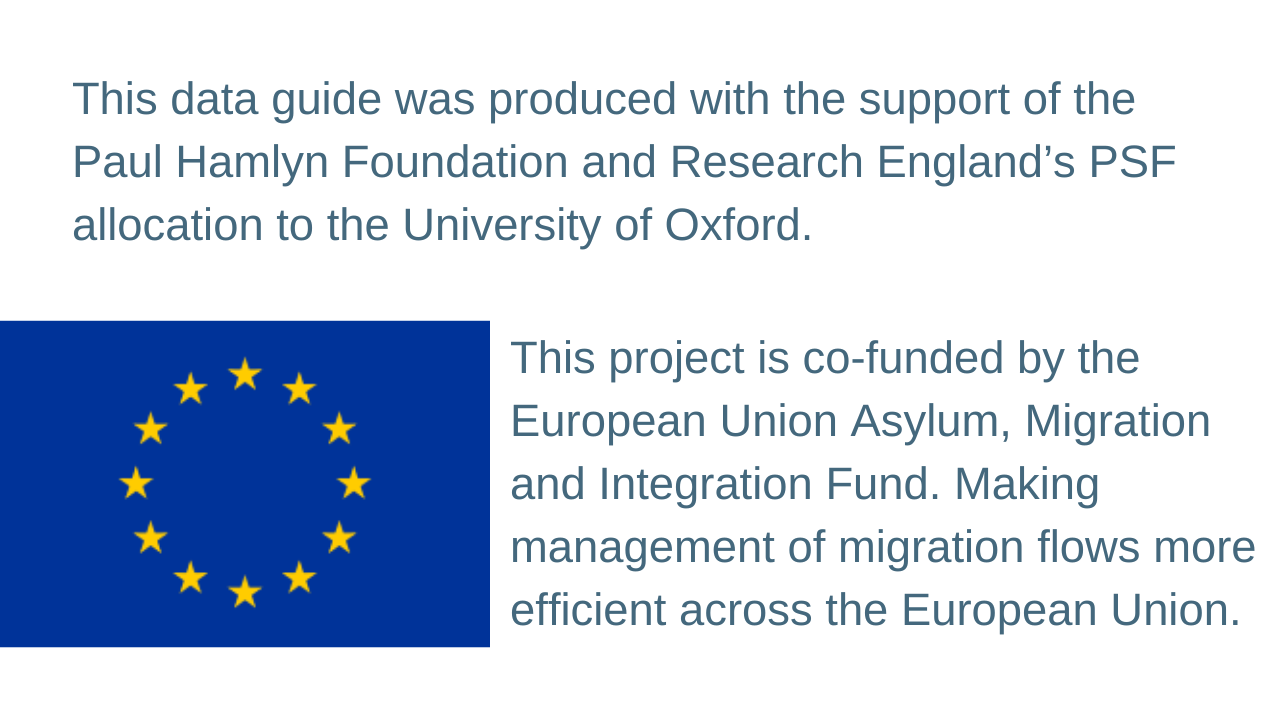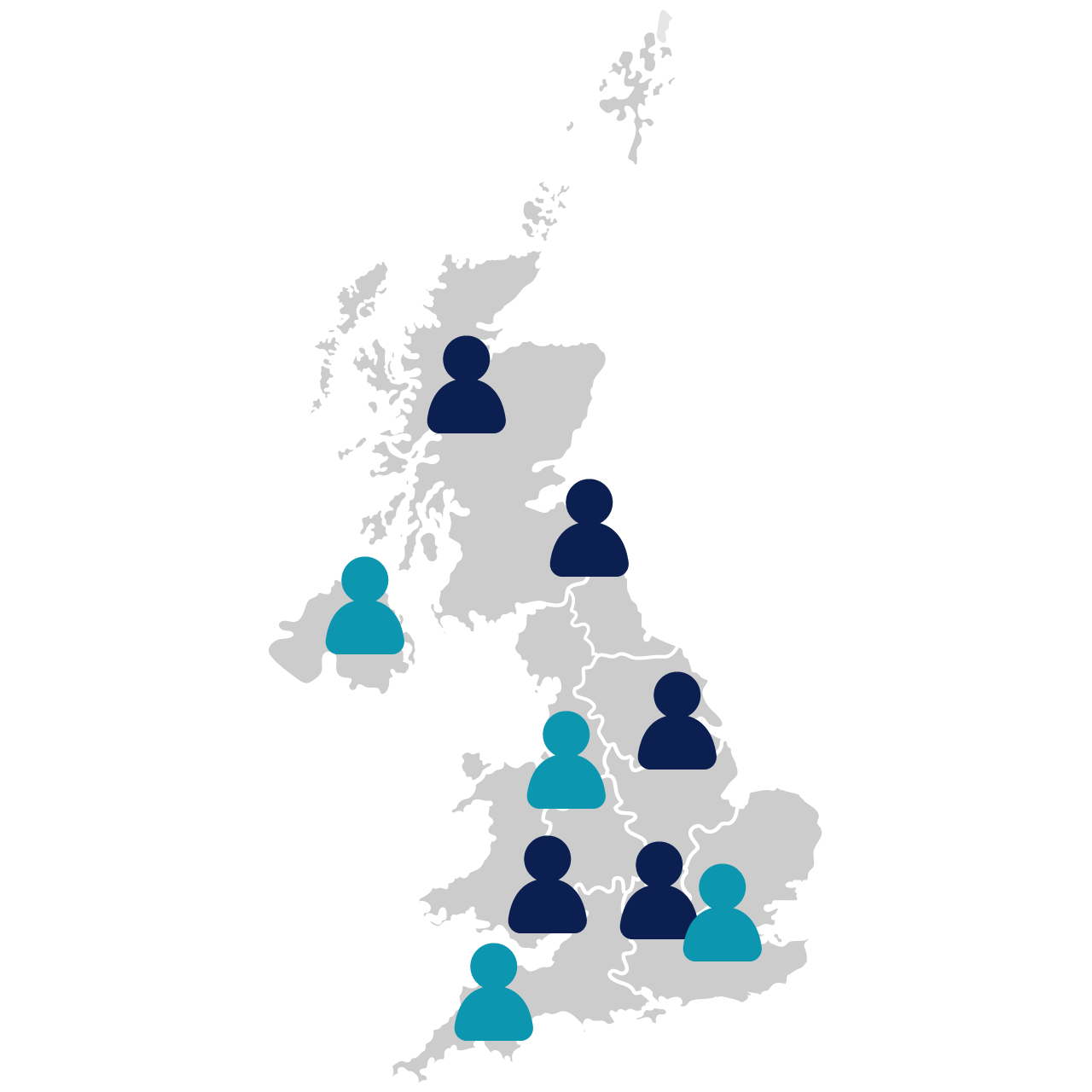This guide has been developed to help people to answer key questions about migrants in local areas around the UK: How many migrants are there in different local areas? How is this changing over time? What do we know about the integration of migrants at the local level?
There are many sources of migration data at the local level. Each source has its own pros and cons, and can be used for different purposes. This guide brings together official data sources on migration at the local authority level, presenting key data in interactive charts and providing links to publicly available data sources. Scroll down or click on the tiles below to get started.
-
Understanding the Evidence
Different data sources define migrants in different ways, and in some cases this will affect how the data should be interpreted. The sources in this guide include data that break down the population by country of birth, nationality, passports held, domicile, immigration status (e.g., asylum seeker, refugee, EU settled status), main language spoken at home, proficiency in English at school and acquisition of British citizenship. Some data sources also distinguish between long-term and short-term migrants, where long-term migrants are those moving for at least 12 months. The Migration Observatory briefing, Who Counts as a Migrant?, provides a more detailed discussion of the implications of using different definitions.
Where a data source allows analysis by both country of birth and nationality/citizenship, this briefing uses country of birth as the default option, because country of birth almost never changes over time but nationality often does. Migration data by country of birth cover those who were born abroad and then migrated to the UK, including UK citizens who acquired UK citizenship through either their parents or naturalisation. Migration data by nationality exclude migrants who have become UK citizens. This means that nationality data should usually not be used to examine changes over time in the migrant population living in the UK. Nationality may be a more useful metric in certain circumstances, however, such as when examining EU citizens in the context of Brexit or if there is a particular interest in people who have been unable or have chosen not to become citizens.
Some data sources measure movements into (immigration) or out of (emigration) the UK. These are often referred to as ‘flows’. Net migration is equal to the difference between the inward and outward flows (immigration minus emigration).
Other data sources measure populations at a given point of time. These are often referred to as ‘stocks’.
There are three main sources of migration data at the local level in the UK used in this guide: the Census, surveys, and administrative records.
Learn more about these data sources, their strengths and their limitations, by clicking on the headers to expand the sections below.
-
Census data
Census data provide a count of people residing in a locality at the time of the Census. Census data provide more accurate figures at the local level ...Click to read more.Census data provide a count of people residing in a locality at the time of the Census. Census data provide more accurate figures at the local level than estimates based on surveys but, as they are only conducted every 10 years in the UK, typically they do not give up-to-date information on population trends.
The latest Censuses in the UK took place in 2021 in England and Wales and Northern Ireland and in 2022 in Scotland. Currently, this guide uses the 2011 and 2021/2022 Censuses in Figure 1 to present the resident population at the local level by country of birth (EU and non-EU).
Data from the 2011 Census appears in Figure 13 to show the share of the population whose main language at home is not English, Gaelic, Scots or Welsh.
This guide will be updated with additional Census data in due course and as they are made available to the public.
To learn more about the Census, visit the ONS website.
Information about the Department for Education’s School Census is available in the section on Administrative data.
-
Survey data
The International Passenger Survey (IPS), long since stretched beyond its original purpose, formed the basis of immigration, emigration and net migration (flow) ...Click to read more.The International Passenger Survey (IPS), long since stretched beyond its original purpose, formed the basis of immigration, emigration and net migration (flow) estimates in what was historically one of ONS’ main migration publications, Migration Statistics Quarterly Report (MSQR). Due to COVID-19, the IPS was suspended on 16 March 2020. It was reintroduced in January 2021 but without the migrant sample boost it previously had, further reducing its value as a source of migration data. The MSQR was retired in August 2020, although ONS still uses the IPS to produce a limited set of tables. ONS continues on its statistical ‘transformation journey’ to make better use of administrative data for their migration statistics.
Separate estimates are produced for long-term (12 months or more) and short-term (3–12 months) immigration, both of which are presented in this guide. To produce long-term immigration estimates at the local authority level, ONS uses the published estimates at larger geographies and then uses administrative data to distribute them across local authorities. Similarly, for short-term immigration estimates, ONS uses published short-term immigration totals derived from the IPS data for non-British workers and students staying for at least 3 but less than 12 months (UN definition). Worker and student totals are then distributed by mapping the IPS definitions as closely as possible to the relevant data within the administrative sources provided by other government departments. In both cases, the national-level IPS estimates come with margins of error, and the local-level numbers are also estimates rather than precise figures, and come with their own, often large, margins of error. Figures 3 and 4 in this guide present these data.
IPS estimates are not sufficient to measure immigration to Northern Ireland, because they do not account for movements across the Irish border. To compensate, the Northern Ireland Statistics Agency (NISRA) has supplemented ONS figures with GP registrations data. One result of this is that short-term immigration estimates are not available for Northern Ireland. Supplementary analysis of the data for Northern Ireland, which is also available through ONS, is provided by NISRA.
Learn more about the IPS and how it was affected by COVID-19 from the ONS.
The Annual Population Survey (APS), which is used for the ONS dataset, Population of the UK by Country of Birth and Nationality, is a survey of individuals and households in the UK. The National Records of Scotland (NRS) also uses the APS to provide estimates specific to Scottish local authorities, in a similar publication called Population by Country of Birth and Nationality. APSdata are used in Figure 1, 2 and 14 of this guide
These data are used in Figure 1 of guide to show the number and share of international migrants living in each local authority.
APS estimates are not available for local authorities in Northern Ireland. The APS does not cover all migrants evenly. Estimates exclude people living in communal establishments – e.g., hotels and caravan parks – and may undercount subgroups of people with lower-than-average response rates to the survey, such as the recently arrived and short-term migrants. Response rates have declined over the past 20 years.
As with the IPS, the ONS suspended face-to-face data collection for the APS in March 2020, quickly transitioning to new methods, such as the use of telephone interviews, which caused problems in four areas:
- weighting the survey;
- inputting for non-response;
- seasonally adjusting the data;
- the quality of survey estimates.
This means that data from 2020 onwards should not be directly compared with data from before the pandemic. Read more about the APS and the impacts of COVID-19 on the APS on the ONS website.
Margins of error in survey data
Caution must be used when examining estimates of small groups because of margins of error. Estimates represent what is considered to be the most likely figure, but the true number could be higher or lower. APS and IPS data are reported with 95% confidence intervals which indicate the margins of error. For example, the estimated non-UK born population residing in the UK in 2020 was 9,539,000, with a confidence interval of +/- 170,000, according to the APS. One effect of this is that it may not be sensible to make too much of the difference between two estimates – small differences may result from statistical noise rather than real changes in the population. Users should look at the trend over several years as in some cases the apparent year-on-year change may be misleading.In some local areas, confidence intervals are quite wide relative to estimates of the population of interest. For example, the estimated EU born population living in Swansea was 10,000 in 2019 and 2020, with a confidence interval of +/-4,000. The corresponding estimate for the year 2018 was 8,000 (+/-3,000). In other words, the data do not show with certainty that the EU born population of Swansea changed between 2018 and 2020, a point that is compounded when taking into account the aforementioned problems with data collection over this period due to the pandemic.
-
Administrative data
Covid-19 changed the way many administrative processes were carried out, in some cases bringing systems nearly to a full stop and creating significant backlogs. ...Click to read more.Covid-19 changed the way many administrative processes were carried out, in some cases bringing systems nearly to a full stop and creating significant backlogs. National Insurance Number registrations and visa applications, for example, were especially impacted. This unprecedented health crisis undoubtedly affected behaviours towards health care professionals, which may be reflected in GP registration data. In light of Covid-19, particular care should be taken when using administrative data sources to illuminate migration trends.
National Insurance Number (NINo) data
National Insurance Number (NINo) data provide information on non-UK nationals at the point they first register for a NINo, with data provided by local authority (the place of residence rather than the place of work).
A NINo is generally required for anyone who wants to work or claim benefits, but will exclude many people who are neither working nor claiming benefits, including children. It is therefore not a measure of international migration inflows, because applicants may have come to the UK months or even years before registering and because some migrants will not have NINos. A person can only register once for a NINo, so if they leave the UK for several years this will not be recorded and if they return they will not be included again in the new registrations data. NINo processing was severely disrupted during the Covid-19 pandemic, further stressing the capacity of this data source to illuminate migration trends.
This guide presents local authority level NINo registration data by nationality in Figure 5.
To learn more about NINo data, please click here.
GP registration data
GP registration data include people registering with a GP for the first time where their previous address was outside of the UK. If someone moves within the UK and registers with a new GP practice, however, this and any subsequent registrations will not be flagged as a migrant registration. GP registration is not compulsory and some migrants will only register with a GP when they require medical attention. As such, these data should not be considered an accurate measure of all immigration inflows.For GP registration data by local authority, see Figure 6 in this guide.
To learn more about GP registration data and its use in the production of official migration statistics, please visit the ONS website.
Home Office data
Home Office data provide information on people in contact with the Home Office for different reasons, e.g., citizenship or asylum applications. Most Home Office data are only available at the national level, although exceptions include data on asylum seekers in receipt of Section 95 support, refugees resettled through the Vulnerable Persons Resettlement Scheme (VPRS) and people attending citizenship ceremonies.Local authority data on asylum seekers in receipt of Section 95 support include asylum seekers who are destitute and whose claims are still pending. The local-authority level figures do not include people on Section 98 support, which is provided while a claim for Section 95 support is being considered, or Section 4 support, which may be provided to asylum seekers whose claims have been refused but who are temporarily unable to leave the UK. People with private incomes are likewise excluded from these statistics.
For local level data on asylum-seekers and refugees, see Figures 7, 8 and 9 in this guide.
For more information about Section 95, asylum and refugee resettlement in the UK please see the Migration Observatory briefing, Migration to the UK: Asylum and Resettled Refugees.
Local-authority level data on applications to the EU Settlement Scheme (EUSS) and their outcomes, which are presented in Figure 15 of this guide, are published by the Home Office on a quarterly basis. This publication contains information on applications by nationality, applications by age group and concluded applications by outcome. It is important to bear in mind the many limitations of these data, which are classified as Experimental Statistics (more information on this classification available here). Perhaps most critically, these data: do not indicate how many people are eligible to apply for the EUSS or how many have not applied; include an unknown number of applications lodged by people who have already left the UK; include multiple applications launched by the same person, i.e., ‘double counting’. For more information on what the data do and do not say, see the Home Office EU Settlement Scheme Statistics User Guide.
To learn more, please visit the Home Office website.
Data on looked-after children
Local authorities in England are required to collect annual data on all children in their care as well as those who are provided with accommodation for a continuous period of more than 24 hours, are subject to a care order under the Children Act 1989, Part IV, or subject to being placed in foster care by the local authority. Unaccompanied asylum-seeking children (UASCs) are recorded in this dataset, so long as they were a UASC at any time during the reporting period and meet the definition of a UASC:- Under 18 years of age when their asylum claim was submitted
- Claiming asylum in their own right
- Separated from both parents and are not being cared for by a responsible adult
UASC status ceases when a child is granted humanitarian protection, UASC leave or refugee status; their asylum claim is rejected; on their 18th birthday.
Data on UASCs in English local authorities are presented in Figure 8.
To learn more, visit the Department for Education’s website.
HESA student data
The Higher Education Statistics Agency (HESA) student data provides information on UK students by place of domicile, rather than place of birth or nationality. Domicile is defined as the place of ‘normal residence’ before taking up study. This means that non-UK domiciled students will include some UK citizens who have been living abroad before coming back to the UK to study. The data primarily come from higher education providers and are supplemented by information from the Initial Teacher Training record (for students on a teaching training course) and the Aggregate Offshore record (for students studying overseas).HESA also collects data on mode of study – full-time versus part-time – and level of study – degree, postgraduate taught, postgraduate research – to name just a few additional variables.
Some of these data are freely available on the HESA website although this guide makes use of a tailored dataset purchased from HESA to show the share of international students among all higher education students for every UK local authority (see Figure 10).
To learn more about HESA’s student data, visit its website here.
Birth statistics
Statistics on the number of live births are produced by the relevant national statistics offices in the UK nations. Date of birth is based on the date of registration rather than the date of the birth itself. In the UK, the mandated period for registering a birth is between 21 (Scotland) and 42 (England, Northern Ireland and Wales) days. This gap between birth and registration, as well as late registrations, means that a small number of births counted in the reference year will have occured in the previous year.At the local level, birth statistics distinguish between UK born and non-UK born mothers. Figure 11 presents births to non-UK born mothers as a share of total births. Many non-UK born mothers will have lived in the UK for a significant period of time before giving birth. Information about fathers’ country of birth is not available by local authority.
For more information see the NISRA (Northern Ireland), ONS (England and Wales) and NRS (Scotland) websites.
School Census data
School Census data cover a range of characteristics of pupils and their schools as of January each year, including first language and ethnicity of pupils. After 2018, the school census no longer includes country of birth and nationality. Like education itself, the production of local authority level data on the first language of school pupils at state-funded schools is a devolved matter in the UK. This information can be accessed as follows:- England: data produced by the Department of Education (DfE) are available online.
- Scotland: similar data, deriving from the student census, is made available for download by the Scottish government, although 2019/20 data were unavailable at time of publication.
- Northern Ireland: similar data on ‘newcomer pupils’ in Northern Ireland is published by its Department of Education. These figures likely exclude those who speak English as an additional language at a high level.
- Wales: the website of StatsWales publishes data on pupils aged 5 and over with a first language other than English or Welsh by local authority, region and year in interactive tables and standard data files, although not by primary and secondary pupils. Data used in Figure 12 were provided to Migration Observatory by StatsWales in response to a request and will be made available on the StatsWales ad-hoc statistical requests webpage.
To protect confidentiality, only data which cannot identify an individual pupil in a given school are made publicly available.
To see the share of primary and secondary pupils with a first language other than English in local authorities, see Figure 12 of this guide. More information is available online.
Population projections
ONS produces population projections for the UK and local authorities based on a number of assumptions, such as the fertility rate, life expectancy and the level of migration. These figures therefore provide some indication of future changes in the size of the immigrant population in relation to the rest of the UK population. Population projections are not forecasts and come with significant uncertainty as a result of changing demographic and economic trends as well as changes to government policy, including migration policy.Population projections are provided separately for England, Wales, Scotland and Northern Ireland and generally cover a period of 25 years. Figure 17 of this guide brings these data sets together.
- England: ONS provides data for download on the expected annual contribution of migration to future populations across local authorities in England for 25 years.
- Scotland: NRS provides similar data to the ONS for local authorities in Scotland.
- Wales: The Welsh Government provides local-level population projections for Wales.
- Northern Ireland: Population projections for Northern Ireland are published by NISRA. The contribution of migration to population growth in local areas is accessible on their website through an interactive dashboard or by downloading the data.
Foreign-born population
Typically, the Census is considered the most reliable source for data on migrants in the UK. However, the Covid-19 pandemic affected the quality of these data in three main ways. 1. People may have moved temporarily to another part of the UK, or outside of the UK, on Census day. 2. This was the UK’s first “online first” Census, which, together with lockdown measures, may have affected coverage and response rates among certain population groups. 3. Scotland held its Census one year after the rest of the UK. While it is difficult to quantify the impacts of these events on the resulting quality of the data, it is possible that migrant sub-groups were particularly affected. Still, compared to other data on migration at the local-level, information from the Census is considerably more robust as it presents counts of people rather than estimates based on samples (see the data sources section above for more information).
Between Censuses, the most up-to-date source of information on the number of migrants residing in local authorities was the Office for National Statistics’ (ONS) Population of the UK by Country of Birth and Nationality dataset for England and Wales, although this publication was discontinued in 2020. Similar data for local authorities in Scotland were available through National Records Scotland (NRS), while estimates prepared by the Northern Ireland Statistics and Research Agency (NISRA) covered the whole of Northern Ireland rather than local authorities.
ONS, NRS and NISRA are experimenting with new methods to estimate the size of migrant populations at the local-level. These data will be presented in this guide in due course.
Information about the foreign born, EU born and non-EU born populations in local authorities in Great Britain are presented in Figures 1 and 2. Further breakdowns (e.g. by nationality, age, sex) are available in the source data.
Figure 1
-
Learn more about these data
The estimates for England and Wales presented in the above chart come from the 2011 and 2021/2022 Censuses.
Download the 2011 source data in this chart from the nomis website (Table QS203UK)
Download the 2021 source data in this chart for England and Wales from the nomis website (Table TS012)
Download the 2021 source data in this chart for Northern Ireland from the NISRA website using the custom table builder
Download the 2022 source data in this chart for Scotland from the UK Data Service website (Table UV204)
Figure 2
-
Learn more about these data
The estimates for England and Wales presented in the above chart come from the ONS dataset, Population of the UK by Country of Birth and Nationality, which is based on from The Annual Population Survey (APS). The National Records of Scotland (NRS) also uses the APS to provide estimates specific to Scottish local authorities, in a similar publication called Population by Country of Birth and Nationality. APS estimates are not available for local authorities in Northern Ireland.
The APS does not cover all migrants evenly. Estimates exclude people living in communal establishments – e.g., hotels and caravan parks – and may undercount subgroups of people with lower-than-average response rates to the survey, such as the recently arrived and short-term migrants. Response rates have declined over the past 20 years.
As with the IPS, the ONS suspended face-to-face data collection for the APS in March 2020, quickly transitioning to new methods, such as the use of telephone interviews, which caused problems in four areas:
- weighting the survey;
- inputting for non-response;
- seasonally adjusting the data;
- the quality of survey estimates.
This means that data from 2020 onwards should not be directly compared with data from before the pandemic. Read more about the APS and the impacts of COVID-19 on the APS on the ONS website.
Download the source data in this chart for England and Wales from ONS
Download the source data in this chart for Scotland from NRS
Changes in the foreign-born population in specific local authorities from one year to the next should be treated with caution, because local-level estimates often come with substantial margins of error. It is therefore better to look at long-term trends rather than year-on-year changes.
As mentioned above, the main ONS dataset providing these data also contains the same local-area information by nationality rather than country of birth (ONS table 2.1). It is important to note when using nationality data that some groups of migrants are more likely to become UK citizens than others (specifically, non-EU citizens are more likely to naturalise than EU citizens) and will therefore not be counted. There are also estimates for the working age (16 to 64 year old) population (ONS tables 1.2 and 2.2).
ONS also provides a dataset broken down by individual nationalities and countries of birth, although in most cases the numbers for individual countries of origin are either too small to estimate or come with large margins of error relative to the estimate itself when looking at the level of local authority.
Long- and short-term immigration inflows
The ONS Local Area Migration Indicators suite and the Scottish Local Area Migration data bring together a range of local-level estimates by country of birth and nationality for most parts of the UK, including the inflow data which are presented in Figures 3 and 4 as a share of the resident population.
Figure 3
-
Learn more about these data
The above figure presents data from what was historically one of ONS’ main migration publications, the Migration Statistics Quarterly Report (MSQR). The MSQR is based on the International Passenger Survey (IPS), which has formed the basis of immigration, emigration and net migration (flow) estimate, despite being long since stretched beyond its original purpose. Due to COVID-19, the IPS was suspended on 16 March 2020. It was reintroduced in January 2021 but without the migrant sample boost it previously had, further reducing its value as a source of migration data. The MSQR was retired in August 2020, although ONS still uses the IPS to produce a limited set of tables. ONS continues on its statistical ‘transformation journey’ to make better use of administrative data for their migration statistics.
Separate estimates are produced for long-term (12 months or more) and short-term (3–12 months) immigration. To produce the estimates of long-term immigration at the local authority level, pictured above, ONS uses the published estimates at larger geographies and then uses administrative data to distribute them across local authorities. National-level IPS estimates come with margins of error , and the local-level numbers, which are also estimates rather than precise figures, come with their own, often large, margins of error.
IPS estimates are not sufficient to measure immigration to Northern Ireland, because they do not account for movements across the Irish border. However, the Northern Ireland Statistics Agency (NISRA) has supplemented ONS figures with GP registrations data, to generate the estimates presented above.
Learn more about the IPS and how it was affected by COVID-19 from the ONS.
-
Learn more about these data
The above figure presents data from what was historically one of ONS’ main migration publications, the Migration Statistics Quarterly Report (MSQR). The MSQR is based on the International Passenger Survey (IPS), which has formed the basis of immigration, emigration and net migration (flow) estimate, despite being long since stretched beyond its original purpose. Due to COVID-19, the IPS was suspended on 16 March 2020. It was reintroduced in January 2021 but without the migrant sample boost it previously had, further reducing its value as a source of migration data. The MSQR was retired in August 2020, although ONS still uses the IPS to produce a limited set of tables. ONS continues on its statistical ‘transformation journey’ to make better use of administrative data for their migration statistics.
Separate estimates are produced for long-term (12 months or more) and short-term (3–12 months) immigration. To produce the estimates of short-term immigration at the local level, ONS uses published short-term immigration totals derived from the IPS data at larger geographies for non-British workers and students staying for at least 3 but less than 12 months (UN definition). Worker and student totals are then distributed across the UK by mapping the IPS definitions as closely as possible to the relevant data within the administrative sources provided by other government departments.
Just as estimates at larger geographies come with margins of error , the local-level numbers, which are also estimates rather than precise figures, come with their own, often large, margins of error.
As is the case with long-term immigration estimates, the IPS is unable to provide sufficiently robust short-term immigration estimates for Northern Ireland, because it does not account for movements across the Irish border. One result of this is that short-term immigration estimates are not available for Northern Ireland. Supplementary analysis of the data for Northern Ireland, which is also available through ONS, is provided by NISRA.
Learn more about the IPS and how it was affected by COVID-19 from the ONS.
Download the source data in this chart from ONS
To facilitate further calculations, ONS provides estimates to the nearest individual (e.g., 3,401 people), Users of the data should bear in mind these estimates are based on a survey that comes with significant confidence intervals and should not be considered as exact as the figures imply.
National Insurance Number registrations (NINo)
In addition to the long-term and short-term immigration inflow data, other sources of data can provide insights into migration at the local level. Although National Insurance Number (NINo) registration data only cover people entering the formal labour market for the first time (i.e., when they register for a NINo), they can be broken down by nationality at the level of local authority. This is not possible with the other frequently updated sources. Caution needs to be taken, however, when interpreting these figures, particularly in light of the Covid-19 pandemic, which effectively suspended NINo registrations for EU citizens. As such, some registrations in 2021 are likely to be from migrants who arrived in 2020. Figure 5 presents the share and number of different nationalities of NINo registrants in local authorities and regions across the UK.
Figure 5
-
Learn more about these data
National Insurance Number (NINo) data provide information on non-UK nationals at the point they first register for a NINo, with data provided by local authority (the place of residence rather than the place of work).
A NINo is generally required for anyone who wants to work or claim benefits, but will exclude many people who are neither working nor claiming benefits, including children. It is therefore not a measure of international migration inflows, because applicants may have come to the UK months or even years before registering and because some migrants will not have NINos. A person can only register once for a NINo, so if they leave the UK for several years this will not be recorded and if they return they will not be included again in the new registrations data. NINo processing was severely disrupted during the Covid-19 pandemic, further stressing the capacity of this data source to illuminate migration trends.
To learn more about NINo data, please click here.
Download the source data in this chart from DWP
The Department of Work and Pensions (DWP) provides further breakdowns for 14 different world regions. Its online system, Stat-Xplore, allows users to examine the data by age, gender and nationality at the local authority level from within their internet browser.
GP registrations
As with NINo registrations, GP registrations were never a perfect reflection of migrant inflows and the Covid-19 pandemic only exacerbated this. The pandemic changed how different population groups interacted with the health system in complicated ways, while simultaneously affecting inflows themselves.
Figure 6
-
Learn more about these data
GP registration data include people registering with a GP for the first time where their previous address was outside of the UK. If someone moves within the UK and registers with a new GP practice, however, this and any subsequent registrations will not be flagged as a migrant registration. GP registration is not compulsory and some migrants will only register with a GP when they require medical attention. As such, these data should not be considered an accurate measure of all immigration inflows.
To learn more about GP registration data and its use in the production of official migration statistics, please visit the ONS website.
Download the source data in this chart from ONS
Asylum-seekers and refugees
Local-level data on asylum-seekers receiving housing or financial support under Section 95 of the Immigration and Asylum Act 1999 are presented in Figure 7. Although not all asylum-seekers receive this type of support, these data present the most accurate and timely picture of the distribution of asylum-seekers across the UK. The figure immediately below presents these data per 1,000 of the resident population; bear in mind that to encourage responsibility sharing amongst LAs, the UK government has set a maximum number of asylum seekers in a given area which is equivalent to 5 asylum-seekers per 1,000 of the resident population.
Figure 7
-
Learn more about these data
The Home Office produces the above pictured local authority-level data on asylum seekers in receipt of Section 95 support, meaning asylum seekers who are destitute and whose claims are still pending. The figures do not include people on Section 98 support, which is provided while a claim for Section 95 support is being considered, or Section 4 support, which may be provided to asylum seekers whose claims have been refused but who are temporarily unable to leave the UK. People with private incomes are likewise excluded from these statistics.
More information about asylum statistics can be found on the Home Office website and the Migration Observatory briefing, Asylum and refugee resettlement in the UK.
Download the source data in this chart from the Home Office
Data on Unaccompanied Asylum Seeking Children (UASCs) who are supported by local authorities are presented in Figure 8. As with asylum-seekers, the government has set out guidance designed to ensure responsibility is shared amongst LAs across the UK: the number of UASCs should not exceed 7 per 1,000 of the 0-17 year old resident population.
Figure 8
-
Learn more about these data
Local authorities in England are required to collect annual data on all children in their care as well as those who are provided with accommodation for a continuous period of more than 24 hours, are subject to a care order under the Children Act 1989, Part IV, or subject to being placed in foster care by the local authority. Unaccompanied asylum-seeking children (UASCs – presented above) are recorded in this dataset, so long as they were a UASC at any time during the reporting period and meet the definition of a UASC:
- Under 18 years of age when their asylum claim was submitted
- Claiming asylum in their own right
- Separated from both parents and are not being cared for by a responsible adult
UASC status ceases when a child is granted humanitarian protection, UASC leave or refugee status; their asylum claim is rejected; on their 18th birthday.
To learn more, visit the Department for Education’s website.
Download the source data in this chart from the Department for Education
There are no official data on where refugees live after their asylum claims have been accepted, although the Migration Observatory has produced regional estimates of people who came to the UK for asylum based on APS data. See the Migration Observatory briefing, Where Do Migrants Live in the UK?
Local-authority level counts of refugees resettled under different types of resettlement schemes are presented in Figure 9. These data are cumulative, meaning they count all instances of resettlement regardless of whether the resettled person has since moved to another area.
Figure 9
-
Learn more about these data
The Home Office publishes local authority-level figures on the number of refugees brought to the UK under different resettlement schemes, such as:
- The Vulnerable Persons Resettlement Scheme (VPRS), launched in 2014 to help refugees of the Syrian conflict. In 2021, it reached its aim of resettling 20,000 people and was closed.
- The Vulnerable Children’s Resettlement Scheme (VCRS), launched in 2016, aimed to resettle 3,000 ‘at risk’ children and their families from the Middle East and North Africa region by 2020. This route was closed with the ending of the VPRS.
- The Gateway Protection Programme (GPP), which was open to refugees from across the global from 2004 to 2020.
The above chart presents data on those resettled under the VPRS and VCRS schemes between 2014 and 2021. Some refugees will have moved to other parts of the UK after their initial resettlement – such changes are not reflected in the data. These schemes were suspended between March and December 2020 in response to Covid-19 – see the ICIBI report, An inspection of UK Refugee Resettlement Schemes (November 2019 – May 2020) for more information on the effect of the pandemic on UK resettlement.
The Home Office website and the Migration Observatory briefing, Asylum and refugee resettlement in the UK, provide additional detail on resettlement statistics.
Download the source data in this chart from the Home Office
For more information about asylum and refugee resettlement in the UK please see the Migration Observatory briefing, Migration to the UK: Asylum and Resettled Refugees.
Migrants from Hong Kong who come to the UK with BNO Visas are not considered asylum-seekers or refugees, although humanitarian protection has been given as a reason for introducing the scheme. For more information, see the Migration Observatory piece, Q&A: The new Hong Kong British National (Overseas) visa.
International students
Although international students are not always thought of as international migrants, and do not typically remain in the UK as long as other types of migrants, they make up a substantial share of people moving to the UK in a given year. The number of EU and non-EU domiciled higher education students, and the share of international students in the total student population, are presented in Figure 10.
Figure 10
-
Learn more about these data
The above figure presents information on higher education students in the UK as reported by the Higher Education Statistics Agency (HESA). HESA collects information about students’ place of domicile (as opposed to country of birth or nationality), which is defined as the place of ‘normal residence’ before taking up study. This means that non-UK domiciled students will include some UK citizens who have been living abroad before coming back to the UK to study. The data primarily come from higher education providers and are supplemented by information from the Initial Teacher Training record (for students on a teaching training course) and the Aggregate Offshore record (for students studying overseas).
HESA also collects data on mode of study – full-time versus part-time – and level of study – degree, postgraduate taught, postgraduate research – to name just a few additional variables.
Some of these data are freely available on the HESA website although this guide makes use of a tailored dataset purchased from HESA.
To learn more about HESA’s student data, visit its website here.
The data used in Figure 10 are part of a tailored dataset produced for Migration Observatory by the Higher Education Statistics Agency (HESA). HESA also publishes open access data to their website, while further breakdowns (e.g., by individual country of domicile) be purchased. For more information about international students, see the Migration Observatory briefing, Student Migration to the UK.
Children and family
Since the 2011 Census, there has been no up-to-date local-authority level data on the total population of either migrant children or UK-born children of migrants. However, the data sources used in Figures 11 and 12, immediately below, provide some insight into numbers and trends of children born in the UK to foreign-born mothers and school pupils with English as an additional language. For information on refugees resettled under the Vulnerable Children’s Resettlement Scheme, see Figure 9, above.
Children born to non-UK born mothers
Data on children born in the UK to foreign-born mothers are available from ONS. They indicate how many children of migrants have been born in a given area, although they do not include babies with a UK-born mother and a non-UK born father. The figures will include foreign-born mothers who have lived in the UK for many years, even decades. Despite their limitations, these data provide some indication of how many such children will reach nursery or school age in subsequent years, although this will also be affected by families moving in and out of the local authority or leaving the UK. Nonetheless, this information can be a useful metric for local-level planning and resource allocation.
The share of births to non-UK born mothers is higher than the share of migrants in the population, in large part because the non-UK born are more likely to be at peak childbearing age (ONS, 2017). In 2018, the overall share of live births to non-UK mothers in England and Wales fell for the first time since 1990, from 28.4% in 2017, to 28.2% in 2018 (ONS, 2018)
Figure 11
-
Learn more about these data
Statistics on the number of live births are produced by the relevant national statistics offices in the UK nations. Date of birth is based on the date of registration rather than the date of the birth itself. In the UK, the mandated period for registering a birth is between 21 (Scotland) and 42 (England, Northern Ireland and Wales) days. This gap between birth and registration, as well as late registrations, means that a small number of births counted in the reference year will have occurred in the previous year.
At the local level, birth statistics distinguish between UK born and non-UK born mothers. Many non-UK born mothers will have lived in the UK for a significant period of time before giving birth. Information about fathers’ country of birth is not available by local authority.
For more information see the NISRA (Northern Ireland), ONS (England and Wales) and NRS (Scotland) websites.
Download the source data in this chart from ONS
More detailed data containing information on the characteristics of the mother are available for England and Wales, through NOMIS, although only at the regional level.
School pupils
The share of children in state-funded schools in whose first language is known or believed (by the school completing the school census) to not be English is shown in Figure 12. Bear in mind that many of these children speak English fluently.
Figure 12
-
Learn more about these data
The above figure presents School Census data on the language of pupils at the local level, in primary and secondary state funded schools. The School Census covers a range of characteristics of pupils and their schools as of January each year, including first language and ethnicity, although it no longer asks about country of birth and nationality. Like education itself, the production of local authority level data on the first language of school pupils at state-funded schools is a devolved matter in the UK. This information can be accessed as follows:
- England: data produced by the Department of Education (DfE) are available online.
- Scotland: similar data, deriving from the student census, is made available for download by the Scottish government.
- Northern Ireland: similar data on ‘newcomer pupils’ in Northern Ireland is published by its Department of Education. These figures likely exclude those who speak English as an additional language at a high level.
- Wales: the website of StatsWales publishes data on pupils aged 5 and over with a first language other than English or Welsh by local authority, region and year in interactive tables and standard data files, although not by primary and secondary pupils. Specially requested data are made available on the StatsWales ad-hoc statistical requests webpage.
To protect confidentiality, only data which cannot identify an individual pupil in a given school are made publicly available.
More information about School Census data is available online.
Download the source data in this chart for England
Download the source data in this chart for Northern Ireland
Download the source data in this chart for Scotland
Data on results in assessments at Key Stage 2 (taken typically at age 11) and GCSE (taken typically at age 16) are available from the Department for Education (DfE) at the local authority level for pupils in England with English as an Additional Language. The data are unfortunately not broken down by country of birth or nationality.
DfE collected data on school pupils by nationality and country of birth for the 2016/17 and 2017/18 academic years in England. There were initial concerns about data quality as the country of birth information and to a lesser extent nationality information was missing for a substantial share of pupils. However, these figures can help to interpret the English as an Additional Language (EAL) data. Specifically:
- The share of EAL is higher among pupils born abroad or who have non-UK nationality. Nonetheless, EAL figures include many pupils born in the UK and who have British nationality.
- In state-funded primary schools in England in January 2017, for example, 8.7% of pupils for whom data were collected were reported to be non-UK nationals and 6.7% were reported to be non-UK born.
- By contrast, a much higher share of pupils, 20.6%, had a first language known or believed to be something other than English. DfE analysis suggested that non-UK born or non-UK national children were more likely to have missing data, making the shares by nationality and (particularly) country of birth underestimates. However, the share of EAL pupils is also expected to be higher because they will include UK-born and UK-national children whose parents speak a language other than English at home.
English language at home
In the UK, English language use and proficiency are seen as a facilitators of integration, resulting in better social and economic outcomes (see, for example, the Home Office’s Indicators of Integration framework). The Census collects information about the main language spoken at home – which does not necessarily indicate skill-level, but is sometimes viewed as a marker of cultural integration. These data, although somewhat dated, are presented in Figure 13. For more information on this topic, see the Migration Observatory briefing, English language use and proficiency of migrants in the UK.
Figure 13
-
Learn more about these data
Census data provide a count of people residing in a locality at the time of the Census. Census data provide more accurate figures at the local level than estimates based on surveys but, as they are only conducted every 10 years in the UK, they do not give up-to-date information on population trends. For some groups, such as Romanians and Bulgarians, most of whom arrived after 2011, these figures are less useful than those from other, timelier sources – for example, the Annual Population Survey. However, for other groups, the Census may still be the best source of data – for example, longer-term residents whose numbers are not likely to shift dramatically over time.
The latest Census in England and Wales took place March 2021, although local level information on migration is not expected to be released until late 2022. Scotland conducted its Census in March 2022. This guide will be updated with data from the 2021 and 2022 Censuses, as they are made available. For the moment, decennial data from 2011 are presented in the above figure.
To learn more about the Census, visit the ONS website.
Download the source data in this chart for England and Wales from NOMIS
Download the source data in this chart for Scotland from NRS
Main language and English proficiency data are available for download from NOMIS for England and Wales (Table LC2803) and from NRS for Scotland.
The data available through NOMIS can also be broken down by age, sex and employment characteristics, although these tables cannot be used to examine the migrant population as they do not include UK and non-UK country of birth or nationality.
For more information on this topic, see the Migration Observatory briefing, English language use and proficiency of migrants in the UK.
Migrants in the labour market
How migrants fare in the labour market is seen as a key facilitator – as well as indicator of – integration. Success in this area is typically due to a range of factors, including their level of education, English language proficiency, personal and professional networks and location in the UK. For more information, see the Migration Observatory briefing, Migrants in the UK Labour Market: An Overview.
Employment rates for the white, minority ethnic and total working age foreign-born population are shown in Figure 14. Interact with the chart to reveal information about the employment rates of their UK-born counterparts. Bear in mind that some areas do not have an estimate, and some estimates come with significant levels of uncertainty; in both cases, this is due to low sample sizes of the foreign-born population with white and/or non-white ethnicity.
Figure 14
-
Learn more about these data
The estimates for England and Wales presented in the above chart come from the ONS dataset, Population of the UK by Country of Birth and Nationality, which is based on from The Annual Population Survey (APS). The National Records of Scotland (NRS) also uses the APS to provide estimates specific to Scottish local authorities, in a similar publication called Population by Country of Birth and Nationality. APS estimates are not available for local authorities in Northern Ireland.
The APS does not cover all migrants evenly. Estimates exclude people living in communal establishments – e.g., hotels and caravan parks – and may undercount subgroups of people with lower-than-average response rates to the survey, such as the recently arrived and short-term migrants. Response rates have declined over the past 20 years.
As with the IPS, the ONS suspended face-to-face data collection for the APS in March 2020, quickly transitioning to new methods, such as the use of telephone interviews, which caused problems in four areas:
- weighting the survey;
- inputting for non-response;
- seasonally adjusting the data;
- the quality of survey estimates.
This means that data from 2020 onwards should not be directly compared with data from before the pandemic. Read more about the APS and the impacts of COVID-19 on the APS on the ONS website.
Download the source data in this chart from NOMIS.
The 2011 Census is a rich and more reliable source of data on local labour market activity and related information than the APS, although it is less timely. Labour market conditions have changed considerably since 2011 and so indicators like employment rates are likely to have changed too. This guide will be updated with data from Census 2021 and 2022, as they are made available. In the meantime, there are some circumstances in which Census data may still be helpful – in examining differences in outcomes between migrants from different countries of origin, for example. Users should bear in mind that the gaps between different groups do not necessarily remain constant over time and are affected by factors such as the duration of residence in the UK.
Census data allow detailed breakdowns of outcomes of different groups by local authority. For example, relevant Census tables for England and Wales include:
- Counts of the non-UK born by economic activity, including employees vs. self-employed (both full-time vs. part time), students, and long-term vs. short-term unemployed: Table LC6203EW and Table DC6210EW (the latter has a more detailed country of birth variable).
- The same factors, with additional breakdowns by age and sex: Table DC6203EW.
- Table DC6218EW: counts of the non-UK born by ‘social grade’ approximated based on occupation of employment.
Comparable data for Scotland are provided in Tables DC6210SC and LC6210SC, as well as the Census data warehouse which contains additional commissioned tables.
There are also sector-specific data, such as figures on the proportion of GPs in England, by Clinical Commissioning Group, whose primary medical qualification was acquired outside of the UK. These data, which are produced by NHS digital, can be accessed and are visualised in the ONS publication International migration and the healthcare workforce.
EU Settlement Scheme
Most EU citizens and their family members who wish to stay in the UK after Brexit are required to apply for settled or pre-settled status under the EU Settlement Scheme programme (EUSS). Figure 15 shows the share and absolute numbers of pre-settled and settled status among all grants of status, by local authority. These figures count people multiple times if they have applied to the scheme more than once (e.g. once to secure pre-settled status and then again to secure settled status). Interact with Figure 14 on a desktop or tablet to reveal rates of rejected and invalid applications.
People granted status through EUSS will not necessarily still be living in the same local authority – some will have moved within the UK or emigrated.
Figure 15
-
Learn more about these data
Local-authority level data on applications to the EU Settlement Scheme (EUSS) and their outcomes, presented above, are published by the Home Office on a quarterly basis and contain information on applications by nationality of applicant, applications by age group and concluded applications by outcome.
It is important to bear in mind the many limitations of these data, which are classified as Experimental Statistics (more information on this classification available here). Perhaps most critically, these data: do not indicate how many people are eligible to apply for the EUSS or how many have not applied; include an unknown number of applications lodged by people who have already left the UK; include multiple applications launched by the same person, i.e., ‘double counting’.
For more information on what the data do and do not say, see the Home Office’s EU Settlement Scheme Statistics User Guide and the Migration Observatory report, Not Settled Yet? Understanding the EU Settlement Scheme using the Available Data.
Download the source data in the chart from the Home Office
The application deadline passed in the summer of 2021. For more information, see the Migration Observatory commentary, What Now? The EU Settlement Scheme after the Deadline, and the Migration Observatory report, Unsettled Status – 2020: Which EU Citizens are at Risk of Failing to Secure their Rights after Brexit?.
Citizenship acquisition
As with EU Settled Status, the acquisition of citizenship confers a suite of rights upon those who receive it, such as the right to vote. It is seen as an important indicator and facilitator of integration, for example in the Home Office’s Indicators of Integration framework. The numbers of foreign-nationals who received British citizenship within and outside of the UK in the last few years are presented in Figure 16.
For a more detailed discussion about citizenship, see the Migration Observatory briefing, Citizenship and naturalisation for migrants in the UK.
Figure 16
-
Learn more about these data
The Home Office publishes administrative data on the number of foreign citizens over the age of 18 attending citizenship ceremonies which, since 2004, is the final step in the naturalisation process.
Download the source data from the Home Office
Population projections
Predicting future migration levels is extremely difficult because the drivers of migration are so complex. ONS produces population projections, which are presented in Figure 17, but users should bear in mind that the UK’s actual future immigrant and total populations are expected to differ from these projections.
Figure 17
-
Learn more about these data
ONS produces population projections for the UK and local authorities based on a number of assumptions, such as the fertility rate, life expectancy and the level of migration. These figures therefore provide some indication of future changes in the size of the immigrant population in relation to the rest of the UK population. Population projections are not forecasts and come with significant uncertainty as a result of changing demographic and economic trends as well as changes to government policy, including migration policy.
Population projections are provided separately for England, Wales, Scotland and Northern Ireland and generally cover a period of 25 years. These data sets are brought together in the above figure.
- England: ONS provides data for download on the expected annual contribution of migration to future populations across local authorities in England for 25 years.
- Scotland: NRS provides similar data to the ONS for local authorities in Scotland.
- Wales: The Welsh Government provides local-level population projections for Wales.
- Northern Ireland: Population projections for Northern Ireland are published by NISRA. The contribution of migration to population growth in local areas is accessible on their website through an interactive dashboard or by downloading the data.
Download the source data in this table for England from ONS
Download the source data in this table for Scotland from NRS
Acknowledgements:

For more information, visit the project page for Measuring Integration at the Local Level on the COMPAS website.

















